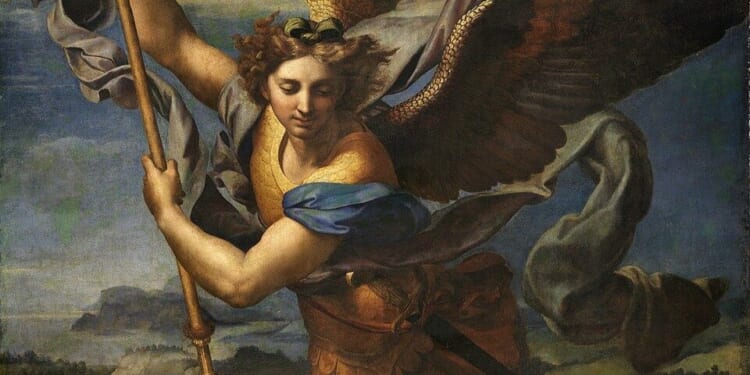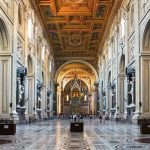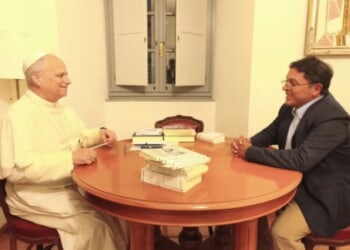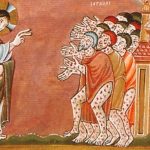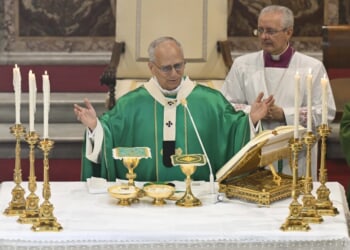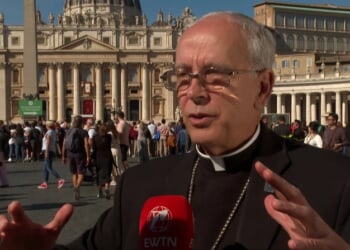St. Michael the Archangel, defend us in battle…
On October 13, 1884, at the end of Mass, Pope Leo XIII went ghostly white and fell into something of a trance at the foot of the altar for about ten minutes. He had heard what sounded like a conversation between two spiritual beings—one voice calm and peaceful, the other guttural and harsh. When the pope snapped out of it, he immediately hurried to his office and penned the St. Michael Prayer.
In the 4th century AD, the Roman Emperor Constantine re-purposed a pagan Roman temple into a basilica in honor of St. Michael. The dedication of the basilica took place on September 29th. Shortly thereafter, September 29th became a feast day in honor of St. Michael—and has been so now for over 1500 years. Through those centuries the feast became known as Michaelmas.
An English history site states that the harvest was to be completed by Michaelmas, which marked the end of the productive season and the beginning of a new cycle of farming.
As Michaelmas is the time that the darker nights and colder days begin—the edge into winter—the celebration of Michaelmas is associated with encouraging protection during these dark months. It was believed that negative forces were stronger in darkness and so families would require stronger defenses during the later months of the year.
Five hundred years ago in England, the lustful and greedy King Henry VIII revolted. He stole Church property and gave it to his friends. Afterwards, the English government broke with ancient traditions in an attempt to obliterate England’s Catholic past—that included the suppression of Michaelmas and its replacement with a harvest festival.
It’s interesting about the stealing of Church property…
In 1945, at the end of World War II, the very Catholic country of Hungary ended up behind the Iron Curtain, headquartered in the Marxist Soviet Union in Russia. The Marxists wasted no time in confiscating almost everything that belonged to the Church. An author wrote: “The Communists were intent that the Church lose its influence on the hearts of the young, and so they ruthlessly stamped out those religious orders whose ministry was teaching [among which were the Hungarian Norbertines].” The Norbertines founded their abbey in Hungary in 1180 AD. They named it in honor of St. Michael the Archangel.
And so, an Abbey that had been in Hungary for close to 900 years was suppressed, and the building was turned into Communist headquarters. However, the founding abbot of St. Michael’s Abbey had a saying, succisa virescit, meaning, “cut down, it will rise again.”
On July 11th, 1950, after being tipped off that the police would be arriving the next day to arrest all the religious at the Abbey, seven priests, with the blessing of the abbot, fled at night across the fields and some of the roughest mountain terrain in the country. Cutting barbed wire, they ventured into minefields before swimming across a sixty-foot-wide river, to venture on to Vienna, Austria, and to freedom.
In crossing the minefields, one priest would lead, risking his life, while the others carefully followed at a distance. It is recorded: “On one occasion, when unsure if Russian soldiers were hidden on the other side of a meadow, one of the priests decided to take the risk of running ahead into the open; he instructed his companions that if he were gunned down, they would know not to follow.”
Those seven heroic Hungarian priests made it to Wisconsin in 1952 and then on to California in 1957, where St. Michael’s Abbey was started in the remote mountains 40 miles southeast of Los Angeles. Those seven priests are now dead, but their order and abbey in California are flourishing.
They dedicated a new Romanesque church in 2021. The church was built in such a manner that every year on September 29th, their patron’s feast day, the sun shoots through the huge rose window and lands directly on the altar.
St. Michael’s Abbey was mentioned in the news recently. On September 3rd, six days after a horrible shooting occurred at Mass in Minnesota, a man who had earlier threatened the Abbey in person and in emails was arrested. He had traveled from Alabama with a cache of weapons, ammunition, and military paraphernalia and reportedly said he came to kill those in the Abbey because they are one of the few places that still “celebrates Michaelmas.”
Back in 1884, after his spiritual encounter, Pope Leo XIII mandated that the St. Michael Prayer be recited at the end of every Low Mass (Mass with no music). After Vatican II, in the mid-1960s, experts in Rome for some reason mandated the prayer no longer be recited. In 1969, the archangels’, Raphael and Gabriel’s, feasts were suppressed, and they were added to the September 29th feast with Michael, in effect ending Michaelmas.
In 1984, Pope John Paul II encouraged Catholics to once again start reciting the St. Michael Prayer after Mass. Three years earlier, in 1981, Pope John Paul was nearly assassinated by a gunman working for the Marxists. That was May 13th. On March 30th of that year, the President of the United States, Ronald Reagan, no friend of Marxism, was also nearly assassinated.
I remember playing basketball in the driveway when my mother came outside and announced the shooting. I was a freshman in high school. I recently read an article by a man who was a freshman in college when President Reagan was shot. He said when it was announced in his classroom a good number of girls in the class started cheering.
Now, why would 18-year-old college girls do such a thing? What or who would possess young ladies into cheering for attempted murder? The writer’s point was that the ghoulish cheering of the recent assassination of Charlie Kirk is not anything new. The cheering has been around for quite some time now. I’d argue a very long time. I’d argue Hell started cheering when Cain slew Abel.
My friends, our battle is not against flesh and blood but against the rulers, against the authorities, against the powers of this present darkness and against the spiritual forces of evil in the heavenly realms (see Ephesians 6:12).
Do you see why it is not a good idea to turn our warrior angels into harmless, smiling little cherubs, the kind found on greeting cards? It is not Scriptural to do that. Angel encounters in the Bible generally provoked great fear. At the beginning of the Bible, an angel with a flaming sword stood guard at the entrance to Eden. And the tenth-to-last paragraph of the Bible tells us how war broke out in heaven: “Michael and his angels fought with the dragon, and the dragon fought with his angels” (Rev. 12:7).
War broke out in heaven. And now, my friends, war has broken out on earth. Now then is the time to go to war for Christ. Now is the time to be saved from the fires of hell, for people do go there. The prophet Amos warned the ancient Jews, who danced and sang while their country devolved into chaos, and Christ warned of the eternal torment that awaited those who did not do His will. He warned of a great eternal chasm, one impossible to cross.
When asked what his plan was for dealing with the Marxist Soviet Union, President Ronald Reagan had a great answer. He simply said, “We win, they lose.” They laughed at Reagan, but he won.
Two thousand years ago they laughed at Christ, but He won. Christ won, hell lost. And we can win too. We are not given time on earth merely to contain the evil around us or simply to tolerate it. No, we are given time to attack these negative forces, to attack hell’s gates.
What might happen to us if we do that? Well, we might get cut down. But so what? Succisa virescit. “Cut down, we will rise again.” Going forward, that is the attitude we need to take. And we need to take St. Michael the Archangel along with us—to defend us in battle.
Image from Wikimedia Commons

